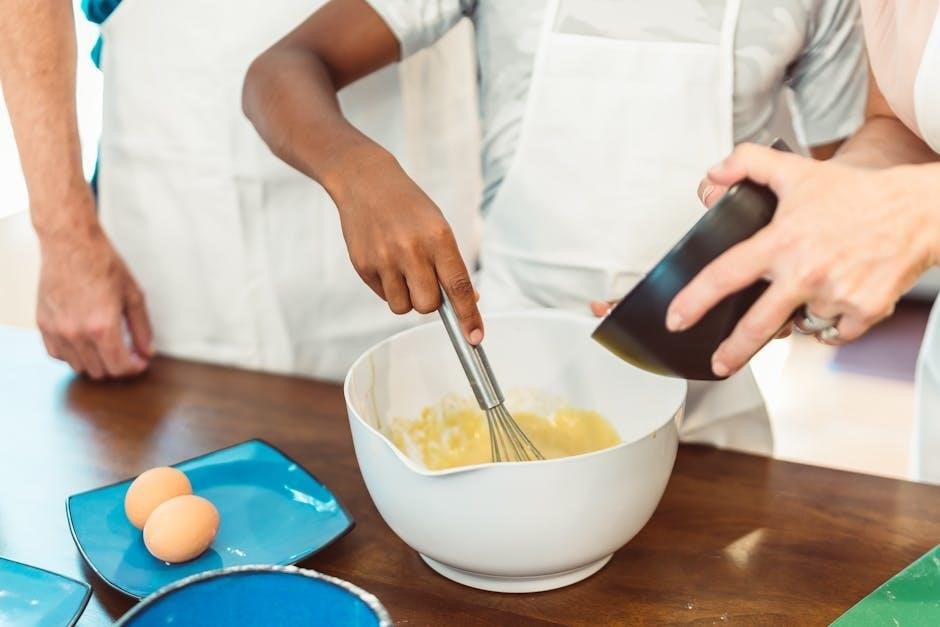Bifen I/T Insecticide: Mixing Instructions
This section provides a comprehensive guide to mixing Bifen I/T insecticide, a versatile solution for controlling over 75 types of insects. Proper mixing is crucial for achieving optimal effectiveness and ensuring safe application, so adhere to the instructions.
Understanding Bifen I/T
Bifen I/T is a popular and effective insecticide known for its broad-spectrum control of numerous pests both indoors and outdoors. It contains bifenthrin, a synthetic pyrethroid, providing long-lasting residual control. Understanding its properties and correct application is essential for successful pest management. This product is widely used by both professionals and homeowners, and its effectiveness is well-documented. Always consult the product label for the most accurate and up-to-date information.
What is Bifen I/T?
Bifen I/T is a multi-purpose insecticide and termiticide. It’s designed for broad-spectrum control of pests indoors and outdoors. Its long-lasting residual effect makes it a popular choice for pest management.
Active Ingredient: Bifenthrin
Bifenthrin, the active ingredient in Bifen I/T, is a synthetic pyrethroid insecticide. It works by affecting the nervous system of insects, leading to paralysis and eventual death. Bifenthrin is effective against a wide range of pests, including ants, termites, spiders, and mosquitoes. Its residual activity provides extended control, reducing the need for frequent re-application. The concentration of bifenthrin in Bifen I/T is 7.9%, ensuring potent pest control while adhering to safety standards when used correctly and according to label instructions.

General Mixing Ratio for Bifen I/T
Understanding the general mixing ratio for Bifen I/T is crucial for effective pest control. This section outlines the standard dilution for various applications, ensuring optimal results while preventing overuse and potential environmental impact.
Standard Dilution: 1 oz per Gallon of Water
The generally accepted standard dilution for Bifen I/T, suitable for many indoor pest control applications, involves mixing 1 ounce of the concentrate with each gallon of water. This ratio is effective for controlling common household pests, including termites, roaches, spiders, and ants. Ensure thorough mixing to create a uniform solution. This dilution provides a balance between efficacy and safety, making it a popular choice for homeowners and professionals. Always refer to the product label for specific instructions.

Specific Mixing Ratios Based on Application
Bifen I/T mixing ratios vary depending on the application site. Indoor pest control will require different dilutions than outdoor treatments. Always consult the product label for specific mixing instructions and application methods.
Indoor Pest Control
For indoor pest control with Bifen I/T, a general mixing ratio of 1 ounce per gallon of water is commonly recommended, effectively targeting termites and other household pests. When applying indoors, focus on areas where pests are likely to harbor, such as cracks, crevices, and baseboards. Be sure to follow all label instructions for safe indoor application. This concentration ensures sufficient strength to eliminate pests while minimizing potential risks. Always ensure proper ventilation when applying indoors and keep pets and children away until the treated area is completely dry.
Outdoor Pest Control
When mixing Bifen I/T for outdoor pest control, it’s essential to consider the specific pests and the area being treated. A common guideline is to mix 0.5 to 1 ounce of Bifen I/T per gallon of water. Apply the solution to grass, plant surfaces, and walls, focusing on areas up to weep holes. This dilution is effective for controlling pests like spiders, ants, fleas, and mosquitoes. Ensure thorough coverage while adhering to label instructions for outdoor use. Always avoid applying Bifen I/T during windy conditions or before heavy rainfall to prevent runoff and maximize its effectiveness.

Enhancing Bifen I/T with Adjuvants
To boost Bifen I/T’s effectiveness, consider using adjuvants like surfactants for better adhesion and synergists like PBO to overcome pest resistance. These additives can improve efficacy and longevity, especially against pyrethroid-resistant pests.
Surfactants for Adhesion
Surfactants play a vital role in enhancing the performance of Bifen I/T by improving its adhesion to various surfaces. These substances reduce the surface tension of the spray solution, allowing it to spread more evenly and stick more effectively to foliage, wood, and even soil particles. This enhanced coverage ensures that the insecticide reaches target pests more efficiently, leading to better control. Using a surfactant is particularly beneficial when treating surfaces that are difficult to wet or have a waxy coating, maximizing the impact of each application.
Synergists (e.g., PBO) for Resistance
To overcome potential pest resistance to Bifen I/T, consider incorporating a synergist like Piperonyl Butoxide (PBO). Synergists enhance the insecticide’s effectiveness by inhibiting the enzymes that pests use to detoxify the active ingredient, bifenthrin. This “supercharges” the pyrethroid, making it more potent and ensuring better control, even in pest populations that have developed some level of resistance. Trade names for these are Exciter and Exponent. Always follow label directions for the appropriate amount of synergist to add to your Bifen I/T mixture for optimal results.

Application Methods
Bifen I/T can be applied through various methods depending on the target pest and location. Common techniques include general surface spraying for broad coverage and mound drenching specifically for ant infestations, ensuring thorough treatment.
General Surface Spraying
General surface spraying is a common method for applying Bifen I/T to control a wide range of pests. This involves using a sprayer to evenly coat surfaces where pests are likely to harbor or travel. Ensure thorough coverage of areas such as baseboards, cracks, crevices, and entry points. When spraying outdoors, focus on vegetation, foundations, and other potential pest habitats. Proper calibration of your sprayer is crucial to achieve the recommended application rate, typically one fluid ounce per 1,000 square feet, ensuring effective pest control.
Mound Drenching for Ants
Mound drenching is an effective method for controlling ant infestations directly at their source. Dilute one teaspoon of Bifen I/T per gallon of water. Apply one to two gallons of the finished dilution to each ant mound. Use sufficient force to penetrate the top of the mound, allowing the dilution to flood the ant channels. Treat a four-foot diameter area around each ant mound to ensure complete coverage. This method targets the entire colony, providing long-lasting control. Always follow the product label for specific instructions and safety precautions.
Safety Precautions and Equipment
Prioritize safety when handling Bifen I/T. Utilize appropriate personal protective equipment (PPE). Ensure sprayer compatibility to prevent equipment damage and ensure effective application. These precautions are paramount for safe and effective pest control.
Personal Protective Equipment (PPE)
When handling Bifen I/T, always wear appropriate personal protective equipment. At a minimum, this includes waterproof gloves, long-sleeved shirt, pants, socks, and shoes. A respiratory protection device is necessary when working in non-ventilated spaces. When mixing and loading using a closed spray tank transfer system, the minimum PPE can be sufficient. Prioritizing safety minimizes potential exposure and health risks. Refer to the product label for comprehensive PPE guidelines specific to the application method.
Sprayer Compatibility
Bifen I/T is compatible with various types of sprayers, including general surface sprayers and those used for mound drenching. Ensure your chosen sprayer is clean and in good working order. Check the sprayer’s compatibility with insecticide formulations to prevent damage or clogging. Confirm that the sprayer can deliver the appropriate application rate for effective pest control. Always rinse the sprayer thoroughly after use to prevent residue buildup and maintain its functionality for future applications.
Storage and Shelf Life
Proper storage is key to maintaining Bifen I/T’s effectiveness. When stored correctly, Bifen I/T typically has a shelf life of 1-2 years. Follow the guidelines to ensure longevity and potency.
Proper Storage Conditions
To maximize the shelf life of Bifen I/T, it’s crucial to store it under the correct conditions. Bifen I/T should be stored in its original container in a cool, dry, and well-ventilated area. Avoid exposure to extreme temperatures, direct sunlight, or moisture. Keep the container tightly sealed when not in use to prevent contamination and degradation. Additionally, it should be stored away from children and pets, in a locked cabinet or storage area if possible, to prevent accidental exposure or misuse. Proper storage ensures the product remains effective and safe for future applications.
Expected Shelf Life: 1-2 Years
Bifen I/T insecticide generally maintains its effectiveness for approximately 1 to 2 years when stored according to the manufacturer’s recommendations. This shelf life can be affected by several factors, including storage conditions. High temperatures, humidity, and exposure to sunlight can accelerate the degradation of the active ingredient, bifenthrin, reducing the product’s efficacy. To ensure the longest possible shelf life, adhere to the recommended storage conditions. Regularly inspect stored containers for any signs of leakage, damage, or product separation, and discard any compromised product properly according to local regulations. Always use the product before the expiration date.
Bifen XTS: A High-Concentrate Option
Bifen XTS presents a high-concentrate alternative, containing 25.1% bifenthrin for increased potency. This oil-based insecticide offers water-resistant, long-lasting control. It is a cost-effective solution when a higher concentration of bifenthrin is needed for pest control.
Bifen XTS Mixing Ratios
When using Bifen XTS, carefully follow the mixing ratios to ensure effective pest control. For general applications, a common mixing rate is between 0.3 to 0.6 fluid ounces per gallon of water. The specific amount will vary depending on the target pest and the severity of the infestation. Always consult the product label for precise instructions tailored to your specific application needs. Using the correct amount ensures that the solution is neither too weak nor too concentrated, optimizing its effectiveness and safety. Over-application can lead to environmental concerns and potential harm to non-target organisms.
Calculating Application Rates
Accurately calculating application rates is essential for effective pest control with Bifen I/T. Determine the area you need to treat and use the product label to find the correct amount of insecticide per unit area.
Area Coverage per Gallon
Understanding the area coverage per gallon of mixed Bifen I/T solution is vital for efficient application. Typically, one gallon of properly diluted Bifen I/T can cover approximately 1,000 square feet when applied as a broadcast treatment. This coverage may vary depending on the surface being treated and the application method used. Adjust application techniques as needed to ensure thorough and consistent coverage. Always refer to the product label for specific coverage details and adjust rates accordingly for optimal pest control results. Accurate measurement ensures you’re neither over- nor under-applying the insecticide.
Additional Considerations
When using Bifen I/T, consider compatibility with other products like IGRs. Always consult the product label for specific instructions, safety precautions, and potential interactions before mixing with other solutions to ensure efficacy and prevent adverse effects.
Mixing with Other Products (e.g., IGRs)
Bifen I/T can be tank-mixed with other products like Insect Growth Regulators (IGRs) such as NyGuard IGR to enhance its effectiveness, particularly against pests with complex life cycles. When combining Bifen I/T with other solutions, it’s essential to follow the most restrictive label precautions and directions for use. Always ensure compatibility by conducting a small-jar test before mixing large quantities. Pay close attention to the specific mixing order and agitation requirements to maintain a homogenous solution.